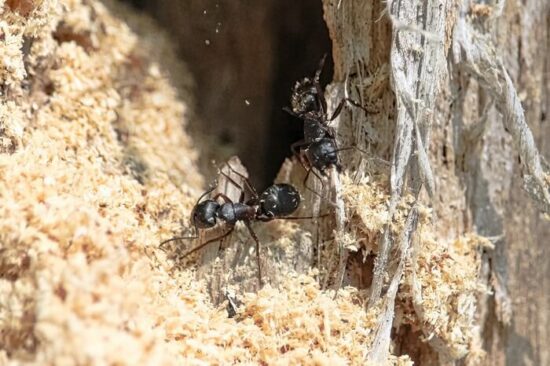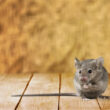It’s important to know how to get rid of carpenter ants in trees if you want to keep your yard healthy. These tenacious insects are notorious for causing significant damage to trees in very little time.
Below, we’ll go over how to kill carpenter ants in a tree and how you can potentially save a tree from their constant assault.
Table of contents
Signs You Have Carpenter Ants In Your Tree
If you notice several relatively large dark brown or black (or perhaps even red or yellow) ants congregating at the base of your tree, you can be pretty confident the tree is infested. You may also see the ants enter and exit the soil around the tree.
Another sign that you have carpenter ants in your tree is sawdust at the base. This isn’t the actual nest, since carpenter ants usually build their nests inside trees. Instead, sawdust is just a product of them disposing of shavings as they chew through the wood. However, you may be able to at least see the opening to the nest.
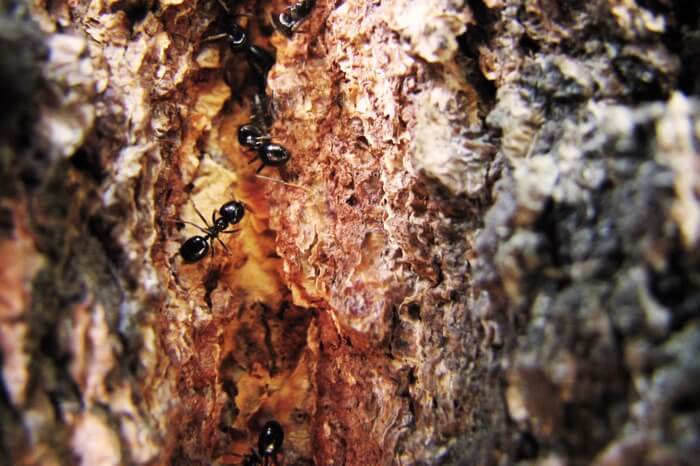
Because carpenter ants need a damp environment, they tend to build their nests in moist wood that has already begun to decay. The ants don’t make the original hole in the tree but rather use an opening that’s already there. The hole may have been the result of a woodpecker’s bill, environmental stress caused by lightning, cold or wind, disease, other insects or animals burrowing, damage from a machine such as a lawn mower or simply a weak branch or crack in the bark. Carpenter ants just take advantage of any damage to more easily penetrate into the wood.
- Kills common household ants including acrobat, crazy, ghost, little black, odorous house, pavement, and other sweet-eating ants
- As worker ants discover the bait, they share it with the rest of the colony to eliminate them all
- You should see a significant decrease in the number of ants visiting the bait stations within just a few days
- Place stations near areas where you’ve seen ant activity
The most telltale sign that you have a tree infested with carpenter ants is a rapidly deteriorating tree. Because these insects attack a tree that’s already decaying, it might be too late to save the tree if you discover the infestation at this stage.
If you still aren’t sure your tree may be infested with carpenter ants you can talk to an ant exterminator who will thoroughly inspect your property for signs and determine the extent of the infestation and damage.
Why Carpenter Ants Are In Your Tree
Carpenter ants in trees are looking for moist places in which to build their nests. That’s why they find dead or decaying wood to be inviting. They also find the soft, brittle wood easy to work with to build their nests.
Quick Tip: Carpenter ants don’t initially create the problem, they just take advantage of the opportunity offered to them. That’s why keeping your trees healthy is such an effective preventative measure.
How To Get Rid Of Carpenter Ants In A Tree
Once carpenter ants have infested a tree, it’s likely they’ll invade any structure that’s located nearby as they search for food or build additional colonies. Because the peak of their activity is in the spring and summer months, that’s the best time to control their population. You’re less likely to be able to successfully locate them when they’re hibernating in the winter.
But getting rid of carpenter ants in a tree can be a bit tricky. You may think that simply sealing or plugging cavities in the tree will solve the problem. However, this will not hinder the tree’s decay. Cutting down the infested tree won’t help either because the carpenter ants will simply move to another tree or structure, even your home!
Getting rid of carpenter ants can be challenging, but before you give up and call an exterminator you should try the following methods yourself.
1. Locate The Nest
When searching for a nest of carpenter ants in a tree, remember there may be more than one colony. You can usually find the main colony (or parent colony) in injured or dying trees, decaying stumps, or in walls or wood in a building that’s exposed to moisture. You’ll find the queen, workers, eggs and young larvae in the parent colony.
Carpenter ants begin to create satellite colonies after the parent colony has been established. You’ll find winged ants, older larvae and pupae in the satellite colonies, which are often located in wood siding and shingles regularly exposed to moisture, rotten window frames and adjacent trees that are in poor health.
Quick Tip: Because there are no eggs in satellite colonies, humidity is not essential. That means a dry environment can be an acceptable habitat.
Once you think you’ve found a colony, look for entry holes, scraping around the tree base if you can’t see any at first. If carpenter ants are exiting from one particular area, it’s a good bet that you’ve found the nest.
An average-sized carpenter ant colony contains about 20,000 workers, but some contain as many as 50,000! That’s why it’s so important to know how to kill carpenter ants in your tree efficiently.
A parent colony consists of one wingless queen and several winged females, which eventually become workers and many of which are infertile. White legless larvae are also located within the colony, as are white eggs and tan-colored pupae. Winged males and queens don’t typically appear for several years until there are between 2,000 and 3,000 workers.
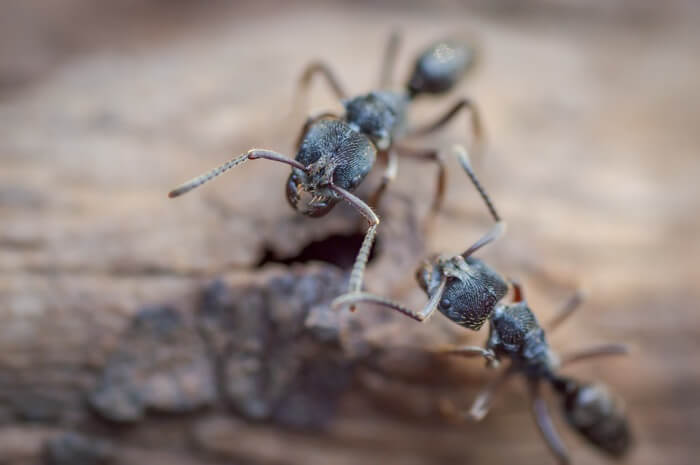
Because carpenter ants are generally nocturnal, you may be able to more easily locate greater numbers of them at night. If you use a flashlight to check about 15 to 20 minutes after sunset, you may be able to spot them leaving the nest in droves in their search for food. To avoid disturbing the ants as you search, cover a portion of the flashlight with your hand or use a flashlight equipped with a red film that covers the lens. Carpenter ants create relatively permanent trails from their nest to their food source, so you can be pretty confident you’ve located the trail once you see ants following it.
2. Use Commercial Insecticides Directly On The Nest
Commercial insecticides are available as either sprays or dusts, and can be very effective ways to kill carpenter ants.
Quick Tip: Whichever method you use, avoid disturbing the nest before you apply the insecticide. If carpenter ants become frightened, they might leave and attempt to build another colony.
The simplest method for getting rid of carpenter ants is to simply apply dust around the base of the tree. In addition to killing the ants who come into contact with the dust, other ants who either eat the carcasses or attempt to carry them back to the colony will themselves ingest the poison.
The most effective dusts contain pyrethroids or carbaryl and are recommended for use on landscape trees. However, if you have a pet cat or community cats in your neighborhood avoid any product containing pyrethroid because this chemical compound is highly toxic to felines.
Some of the most effective long-term methods for getting rid of carpenter ants are liquid sprays that are combinations of a sugar-based bait and borax. To use, just spray everything from inside and around the nest cavity to the tree starting at the base and up the trunk as far as possible. You need to cover as much area as you can in order to reach any ants that may attempt to escape. Be sure to thoroughly spray the inside so you can be sure to kill the queen carpenter ant and thus render the rest of the colony helpless.
It’s a good idea to also spray any trails to satellite colonies so the carpenter ants will carry the insecticide back to the parent colony, passing it on to others.
As a rule, carpenter ants actually live above the entrance to the nest. To get them to escape, spray room defogger into the entrance, which should cause the ants to exit the nest. As they escape, just spray them with the insecticide. Not only will they die but it should also kill other carpenter ants who eat the dead bodies (which is common).
3. Place Ant Bait Around The Base Of The Tree
Although you might not get immediate results, ant bait can prove to be the most effective method for getting rid of carpenter ants in a tree. This method is ideal if you’re not sure if there are satellite colonies in addition to the parent colony. By using ant bait, you’ll be able to tell exactly where the nest is as you watch the worker carpenter ants carry the bait back to the queen and larvae.
- Kills common household ants including acrobat, crazy, ghost, little black, odorous house, pavement, and other sweet-eating ants
- As worker ants discover the bait, they share it with the rest of the colony to eliminate them all
- You should see a significant decrease in the number of ants visiting the bait stations within just a few days
- Place stations near areas where you’ve seen ant activity
Baits are available as either plastic stations or ant stakes. Sweet foods such as sugar or high-protein foods such as mealworms work well as baits. Combine these foods with boric acid, and you’ll have an instant carpenter ant killer. Boric acid is a poisonous chemical compound, so be sure to keep it away from kids and pets.
Set the bait around the tree and on any visible ant trails. Never use a bait and a repellent insecticide together because the insecticide will repel the carpenter ants away from the bait, rendering both useless. However, it’s fine to use another form of insecticide along with a bait. For best results, always make sure you carefully follow all instructions for using an ant bait or any pest control product for that matter.
4. Spray The Tree With A Peppermint Oil Mix
If you’re hesitant to use insecticides or other harsh chemicals around kids or pets, there are natural methods you can try to get rid of carpenter ants in your tree.
An excellent natural remedy is a peppermint oil solution. Carpenter ants despise peppermint oil and will do everything in their power to escape it. Just add about 30 drops of oil to one gallon of water, mix thoroughly and spray as much of the tree as you can, focusing on the base where the nest is usually found. You’ll need to reapply the solution for a few days or so to make sure it’s effective and to get the best results.
Another natural method that’s effective in eradicating carpenter ants is cedar oil, which dries out the ants, leading to their suffocation. Just thoroughly spray the oil around the tree and repeat the process until you see results.
Available in powder form, food grade diatomaceous earth is another natural method you can try to get rid of carpenter ants that have infested a tree. This abrasive product damages the insects’ joints and exoskeletons, leading to a slow death. Just apply this safe, organic powder on the nest and around the base of the tree, but be sure to reapply it following a rain!
5. Check To See If The Ants Have Infested Nearby Trees
Check any nearby trees and the surrounding area to make sure the foliage is in good health and that carpenter ants haven’t built satellite colonies. If they have, use the methods above to kill them and save the tree.
Ways To Prevent Carpenter Ants From Coming Back
The best way to prevent a carpenter ant infestation from coming back is to make sure your trees are healthy and in good condition.
Quick Tip: However, you should only remove an infested tree if it’s not salvageable and is a threat to the safety of your property.
If your tree isn’t salvageable and you have the skills and equipment to safely cut it down, there are some steps you need to take. First, you must make sure that you and those assisting you know what procedures to take to ensure you can safely complete the project. Carefully create a plan to make sure no surrounding trees, structures or animals will be harmed. One of the most important steps to take is ensuring that no one ever operates a chain saw alone.
Next, make sure you have all the equipment you’ll need, including, but not limited to, hard hats, eye and ear protection, boots, gloves, a first aid kit, a chain saw and chain, gas for the saw, wedges and a single-bit axe. Make sure your chain saw isn’t dull or damaged and that it’s working properly.
Plan precisely as to the direction you want the tree to fall. Inspect the tree to see if there are any parts that could break off and fall in other directions and if there are curves near the base of the tree that might cause it to uproot as it falls. Also, look out for utility lines in the area. Finally, consider the weather and avoid cutting if the wind is gusty or if fog or smog obstructs your view.
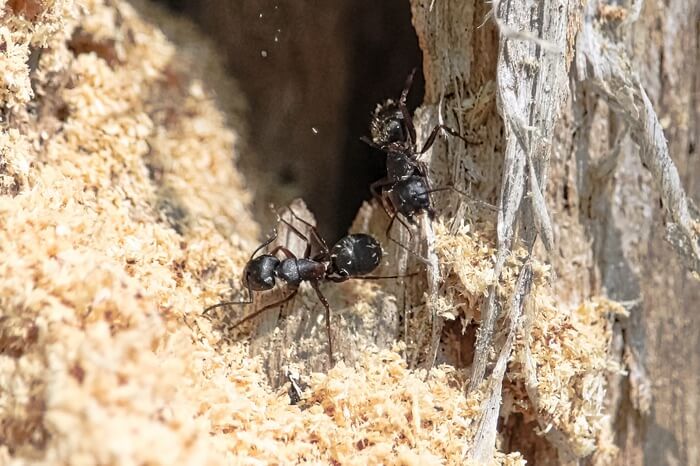
Don’t forget to create an escape plan in case of an emergency. Plan to take a path in the opposite direction of where you intend the tree to fall.
Your first step, and probably the most important, in actually cutting down the tree is creating an undercut that will determine the direction in which the tree can safely fall. Make sure the cut is the correct depth.
Never begin the second step until you stop the chain saw and alert your assistants. This second step, known as the back cut, makes the tree fall. A horizontal cut, the back cut must never be lower than the undercut; if it is, the tree will fall back on you! Be sure to leave some wood between the undercut and the back cut, and insert a wedge into the back cut to allow the tree to fall in the right direction.
Throughout the entire process, continue to make sure the surrounding area is safe and that there are no branches or limbs caught in adjacent trees or structures.
How Much Damage Can They Cause?
Although carpenter ants don’t initially cause the damage to your tree, they do take advantage of the opportunity to create further destruction. These are wood-boring insects, but don’t actually eat it. They instead cast it aside as sawdust, a combination of wood and dead insects.
Because they work so efficiently (hence their name), carpenter ants can quickly build a complicated system of connected tunnels. The further the ants burrow into your tree, the more the branches and limbs will slowly die and the leaves will wither. As the damage worsens, the entire tree will dry out and gradually weaken.
If you simply cut down the infested tree or trees, carpenter ants will just seek other places to build their colonies, including any building constructed of wood. There they’ll infest windows, door frames, or decks. Carpenter ants can also cause significant damage to your garden as they make their tunnels underground. This is why it’s important to get rid of carpenter ants in a tree properly, so you don’t create problems for yourself in the future.
Species Of Trees That Carpenter Ants Like The Most
Because other factors have already created suitable living conditions, you’re more likely to find carpenter ants in dead trees and stumps. However, the ants will take advantage of any opportunities afforded to them and will often infest living trees if the conditions are right. Carpenter ants especially prefer any tree that offers them one of their favorite foods, aphid excrement, known as honeydew.
That means carpenter ants tend to infest trees where aphids make their home. Common types of trees that fit this description are”
- Sugar maple
- Oak
- Northern white cedar
- Balsam fir
- Pine
- Cherry
- Plum
- Almond
- Sweetgum
Also known as plant lice, aphids are small, soft-bodied insects that come in nearly every color of the rainbow! Through their long mouthpart, known as a proboscis, aphids feel on the undersides of leaves near the stem or on small buds or shoots. During this process, they secrete honeydew, the sticky fluid that carpenter ants relish. If a large cluster of aphids feeds at the same time, the honeydew will literally drop off the leaves and tree, and what could be more enticing than that for carpenter ants?
If your tree is infested with aphids, there’s a good chance it’s also infested with carpenter ants. Getting rid of the carpenter ants in your tree should also take care of the aphid infestation because ants are actually the aphids’ “protectors” from their natural enemies.
Conclusion
As you can see, learning how to get rid of carpenter ants isn’t nearly as challenging as it seems. While these insects are tough to deal with at times, a combination of preventative measures and smart removal will help you save the trees in your yard.
We hope you found this guide helpful. If you have any questions don’t hesitate to ask them!
